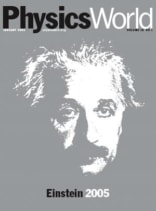What would Albert Einstein think if he were alive today?
 As someone who disliked the limelight, he would probably be embarrassed by the celebrations that are planned as part of the International Year of Physics to mark the centenary of his remarkable achievements in 1905. As a theorist who was interested in experiments, in his early career at least, he would be pleased to know that a small band of 21st-century physicists are still trying to find flaws in the special theory of relativity, while others are busy checking out the predictions of the general theory. And having spent the final years of his life trying to unify general relativity with electromagnetism, without success, he could be forgiven for thinking that criticisms of his relative non-productivity in those years were somewhat unfair. No-one else has succeeded where he failed.
As someone who disliked the limelight, he would probably be embarrassed by the celebrations that are planned as part of the International Year of Physics to mark the centenary of his remarkable achievements in 1905. As a theorist who was interested in experiments, in his early career at least, he would be pleased to know that a small band of 21st-century physicists are still trying to find flaws in the special theory of relativity, while others are busy checking out the predictions of the general theory. And having spent the final years of his life trying to unify general relativity with electromagnetism, without success, he could be forgiven for thinking that criticisms of his relative non-productivity in those years were somewhat unfair. No-one else has succeeded where he failed.
It is impossible to overstate the importance of what Einstein did in 1905. His work on Brownian motion provided the theoretical framework for experiments to prove that atoms were real. Hard as it might be to believe now, at the time the majority of physicists did not believe in atoms. The special theory of relativity completely changed our notions of space and time, while E = mc2 led to the remarkable conclusion that mass and energy are one and the same. And his work on the photoelectric effect was the start of a love-hate relationship with quantum mechanics that still fascinates physicists today.
And 1905 was just the beginning. The general theory of relativity – his truly outstanding achievement – followed 10 years later, with its predictions for the bending of light by mass being confirmed a few years after that during the solar eclipse of 1919. But even then Einstein did not abandon his interest in atoms, photons and quantum mechanics. The Einstein A and B coefficients for spontaneous and stimulated emission – without which we would not have lasers – made their debut in 1916, and the prediction of Bose-Einstein condensation – one of the hottest topics in experimental physics for the past decade – followed in the 1920s.
This special issue of Physics World covers all this and more. Mark Haw describes Einstein’s theory of Brownian motion as a “slower, subtler revolution” than his work on relativity or quantum mechanics, but just as influential nonetheless. Clifford M Will provides an update on the renaissance in experimental gravitational physics and reports how the general theory has so far survived all scrutiny, although it has not yet been tested in the strong-field limit. Most exciting, however, is the fact that theories that seek to unify gravity with the three other fundamental forces of nature predict departures from general relativity that will soon be within experimental reach.
Of course, the outstanding prediction of general relativity that has yet to be confirmed is the existence of gravitational waves: Jim Hough and Sheila Rowan describe the almost superhuman efforts that are being made to find out if Einstein was right on this occasion (p37, print version only). And as if to show that the great physicist could also be wrong, Harald Weinfurter reports on the state of the art in quantum entanglement – the phenomenon that Einstein once dismissed as “spooky action at a distance” (p47, print version only). Other topics covered range from Einstein’s love of music to the way his image is protected by the Hebrew University of Jerusalem and a Hollywood agent.
These articles are obviously preaching to the physics converted, but the organizers of the International Year of Physics – also known as World Year of Physics and Einstein Year – have much loftier ambitions. Through a world-wide programme of events, demonstrations and other activities they hope to inspire the next generation of physics students. Einstein would have approved.


